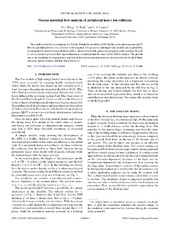Viscous potential flow analysis of peripheral heavy ion collisions
Peer reviewed, Journal article
Published version
Permanent lenke
https://hdl.handle.net/1956/9169Utgivelsesdato
2013-02-19Metadata
Vis full innførselSamlinger
Originalversjon
https://doi.org/10.1103/physrevc.87.024908Sammendrag
The conditions for the development of a Kelvin-Helmholtz instability (KHI) for the quark-gluon plasma (QGP) flow in a peripheral heavy ion collision is investigated. The projectile and target side particles are separated by an energetically motivated hypothetical surface, characterized with a phenomenological surface tension. In such a view, a classical potential flow approximation is considered and the onset of the KHI is studied. The growth rate of the instability is computed as a function of phenomenological parameters characteristic for the QGP fluid: viscosity, surface tension, and flow layer thickness.
